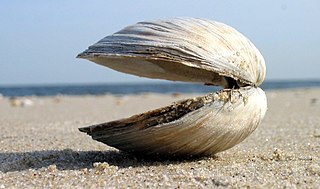
Clam is a common name for several kinds of bivalve molluscs. The word is often applied only to those that are edible and live as infauna, spending most of their lives halfway buried in the sand of the seafloor or riverbeds. Clams have two shells of equal size connected by two adductor muscles and have a powerful burrowing foot. They live in both freshwater and marine environments; in salt water they prefer to burrow down into the mud and the turbidity of the water required varies with species and location; the greatest diversity of these is in North America.
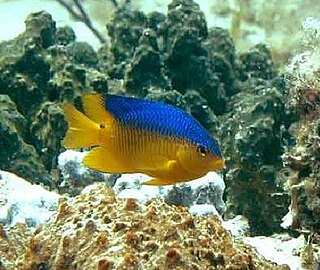
Damselfish are those within the subfamilies Abudefdufinae, Chrominae, Lepidozyginae, Pomacentrinae, and Stegastinae within the family Pomacentridae. Most species within this group are relatively small, with the largest species being about 30cm in length. Most damselfish species exist only in marine environments, but a few inhabit brackish or fresh water. These fish are found globally in tropical, subtropical, and temperate waters.
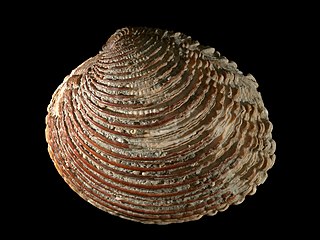
The Veneridae or venerids, common name: Venus clams, are a very large family of minute to large, saltwater clams, marine bivalve molluscs. Over 500 living species of venerid bivalves are known, most of which are edible, and many of which are exploited as food sources.

The bicolor angelfish is a marine species of fish, easily recognizable by its yellow tail, yellow front half of their body, and blue rear with blue patterns above and around the eye. Other names of this angelfish include: Pacific rock beauty, oriole angelfish, oriole dwarf angel, blue and gold angel, and two-colored angel. The life expectancy in the wild varies greatly, depending on location, and ranges between 5 and 13 years. These fish tend to grow to a maximum of 6 inches in length. The larval stages lasts approximately 32 days.
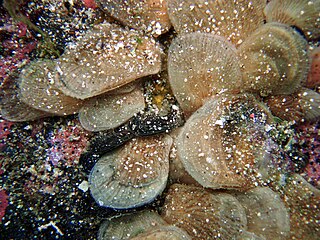
Isognomon is a genus of marine bivalve mollusks which is related to the pearl oysters.

Cetoscarus bicolor, also known as the bicolour parrotfish or bumphead parrotfish, is a species of fish belonging to the family Scaridae. It is found only in the Red Sea.

Tivela is a genus of saltwater clams, marine bivalve molluscs in the subfamily Meretricinae of the family Veneridae, the Venus clams.

Tivela stultorum, also known as the Pismo clam, is a species of large, edible, saltwater clam, a marine bivalve mollusk in the family Veneridae, the Venus clams. This species is native to the eastern Pacific Ocean. As the name implies, the Pismo clam lives in Pismo Beach, California. It has been found at least as far south as 300 miles south of the US–Mexico border in Baja California on the Pacific Ocean side, where strong surf sometimes washes ashore live clams. The indigenous peoples of California used this species for food.
Homalopoma bicolor is a species of sea snail, a marine gastropod mollusk in the family Colloniidae.

Scabricola bicolor is a species of sea snail, a marine gastropod mollusk in the family Mitridae, the miters or miter snails.

Typhinellus is a genus of sea snails, marine gastropod mollusks in the family Muricidae, the murex snails or rock snails.
Hypothalassia acerba is a large crab found in the muddy substrates of the deep seas off the southwestern Australian and New Zealand coasts. Australian distribution, which is correlated to depth and temperature, ranges from a latitude as far north as approximately 27° S on the west coast, southwards, then eastwards on the south coast to a longitude of at least 129° E. The species usually occurs in waters with temperatures of 13–19 °C (55–66 °F) and in depths ranging of 200–255 metres (656–837 ft) on the lower west coast and 90–200 m (300–660 ft) on the south coast. Body size is inversely related to depth of water. There are only two species in the genus Hypothalassia, and H. acerba is not the same champagne crab as the other Hypothalassia species, H. armata, which is found in Japanese waters.
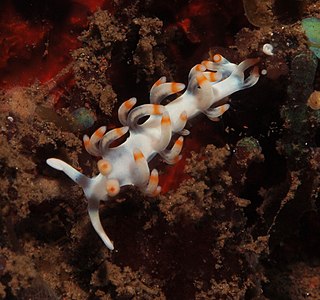
Samla bicolor is a species of sea slug, an aeolid nudibranch, a marine heterobranch mollusc in the family Samlidae.

Paracirrhites is a genus of marine ray-finned fish, hawkfishes belonging to the family Cirrhitidae. These fishes are found on tropical reefs of the Indian Ocean and Pacific Ocean.

Pycnochromis margaritifer, known commonly as the bicolor chromis, is a species of marine fish in the family Pomacentridae. The species was reclassified as Pycnochromis margaritifer in 2021, and is still listed under the former name Chromis margaritifer in some places.
Geodia bicolor is a species of sponge in the family Geodiidae. It is found in the waters of the Pacific Ocean off the coast of California.

Tivela mactroides is a species of bivalve belonging to the family Veneridae.

The Hawaiian chub, also known as the insular rudderfish or bicolor chub, is a species of marine ray-finned fish, a sea chub belonging to the family Kyphosidae. This species is found in the Central Pacific Ocean.














